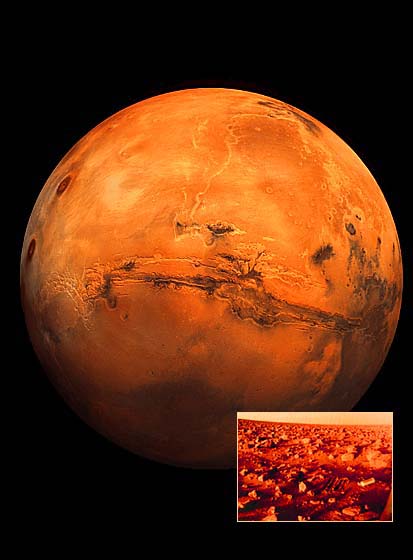
(Background) The red planet, Mars, shown in true color here, displays an array of fascinating surface features. Most prominent in this Viking-mission image is the Mariner Valley, a vast "canyon" named after an earlier spacecraft, Mariner, that discovered it. The valley extends for approximately 4000 km—roughly the width of the United States.
(Inset) A close-up view of the rock-strewn Martian surface, as seen from a camera onboard Mars Pathfinder, which landed in the Ares Vallis region of Mars some 1000 km north of the equator. The landing site lies in an outflow channel—a vast trench carved in the Martian surface some 3 billion years ago by catastrophic floods which carried millions of tons of material from the planet's southern highlands down into the northern plains. The Sojourner rover can be seen surveying the debris field near the center of the image. For reference, the largest boulders near the rover are about 30 cm high; the horizon is about 1 km away.
Studying this chapter will enable you to:
Summarize the general orbital and physical properties of Mars.
Describe the observational evidence for seasonal changes on Mars.
Compare the surface features and geology of Mars with those of the Moon and Earth, and account for these characteristics in terms of Martian history.
Discuss the evidence that Mars once had a much denser atmosphere and running water on its surface.
Compare the atmosphere of Mars with those of Earth and Venus and explain why the evolutionary histories of these three worlds diverged so sharply.
Describe the characteristics of Mars's moons and explain their probable origin.
Named by the ancient Romans for their bloody god of war, Mars is for many people the most intriguing of all celestial objects. Over the years it has inspired much speculation that life—perhaps intelligent, and possibly hostile—may exist there. With the dawn of the Space Age, those notions had to be abandoned. Visits by robot spacecraft have revealed no signs of life of any sort, even at the microbial level, on Mars. Even so, the planet's properties are close enough to those of Earth that Mars is still widely regarded as the next most hospitable environment for the appearance of life in the solar system, after Earth itself. At about the same time as Earth's "twin," Venus, was evolving into a searing inferno, the Mars of long ago may have had running water and blue skies. If life ever arose there, however, it must be long extinct. The Mars of today appears to be a dry, dead world.